Marco Solorio of OneRiver Media takes a close look into (literally) Blackmagic Design’s new 1080 HD OLED Electronic Viewfinder. Could this product be another disrupter in the video production industry?
As mentioned in Part 1 of this series, the OneRiver Media facility is located about 30 minutes away from Blackmagic Design, allowing me to meet with my friends there and play with new gear. Having used a prototype of Blackmagic’s new OLED EVF on the URSA Mini, I can say this is absolutely not your average EVF. In fact, Blackmagic took the concept of what an EVF is and took it to a whole new level.
There’s something really great about using an EVF (Electronic Viewfinder) when shooting video with a camera. The only thing better in some cases is a true optical viewfinder, as used in traditional celluloid-based filmmaking.
But with today’s growing technology in the digital cinema industry, a big bonus when using an EVF are various modes in which one can view their image. This can include focus peaking, image zoom, false color, camera data overlays, black-and-white mode, and so much more; something optical viewfinders of old could not do.
The holy grail is merging the two forms of “viewfinding” where digital overlays can assist in the decision making on what would look and feel like an optical viewfinder. This is where Blackmagic Design’s new 1080 HD OLED EVF comes into play.
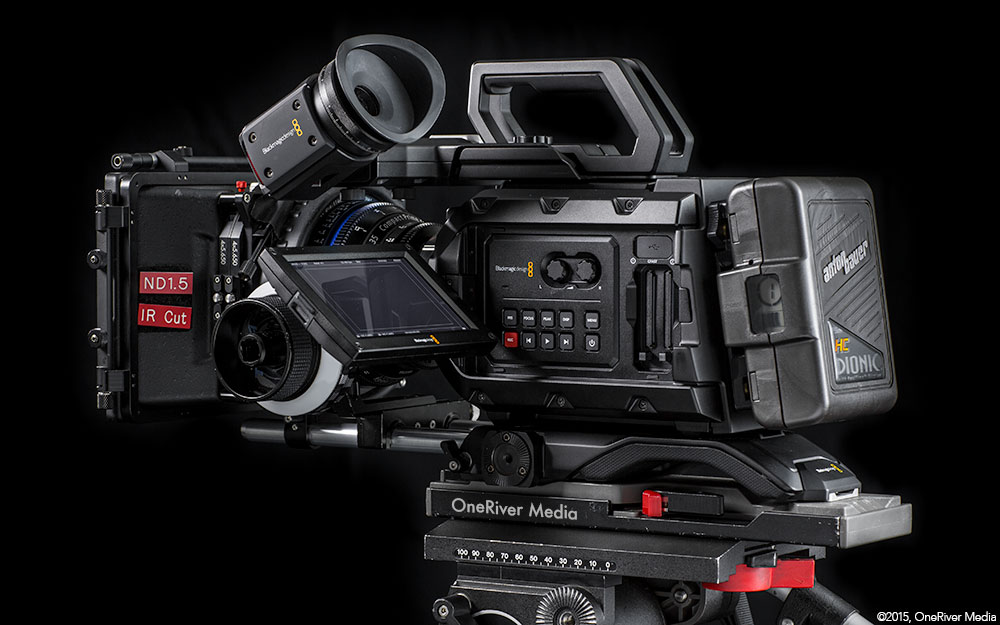
The Blackmagic OLED EVF is a perfect fit on the URSA Mini.
OLED Element
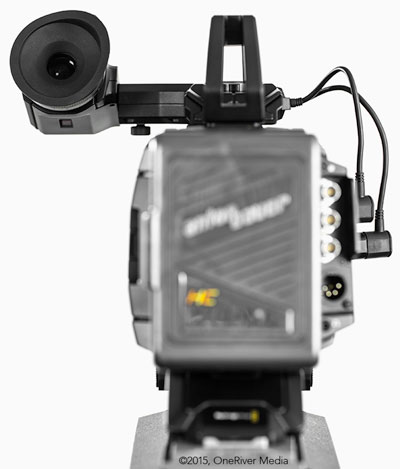
At the heart of this EVF is a full 1920×1080 raster OLED element. If you’re not familiar with OLED technology, it’s currently the best way to really view images on a screen since each pixel is assigned a light value, rather than the entire panel itself having a global backlight. This translates to black levels being true black, rather than black with light behind it. The end result is an image with astounding contrast ratios. An added bonus is that the OLED element itself automatically turns off when the eyepiece itself is not cupped to the eye, thus preserving and prolonging the life of the OLED element.
But OLED technology is only part of the picture (sorry for the pun). In the case with Blackmagic’s full 1080 raster in their OLED element, the pixels are so small that you can’t actually individually see each of those pixels. The result is an image that looks and feels much like an actual optical viewfinder. By all accounts, this OLED pixel density a pretty big deal.
Glass Optics
The third part of the puzzle to making this EVF an exceptional piece of gear is the glass. The optical element is a solid piece of high quality glass that is permanently set in place. One of the drawbacks of other EVFs that incorporate a flip-out loupe is that the precision and optical quality of that method is typically inferior in comparison. With the Blackmagic’s EVF constructed as one solid piece, the optical path and resolving quality is of very high quality.Scanning Size
The forth biggest point to cover is the size of the OLED element itself. If an EVF has too large of a screen inside of it, the eye tends to overscan the image, sometimes resulting in fatigue on long shoot days and even the potential for bad composition and framing of the shot. By not having an overly large OLED element in the Blackmagic EVF, your eyeball can stay put without having to wander through the EVF for proper framing of the shot.There’s a large diopter ring at the eyecup that allows you to change the focus of the glass element. Although the focus range could arguably be a bit longer, I found it to not be a problem in consideration of the fact I have excellent vision (thanks mom and dad) and don’t wear glasses or contacts. For people that do wear glasses, they might feel the focus to be a bit on the short end.
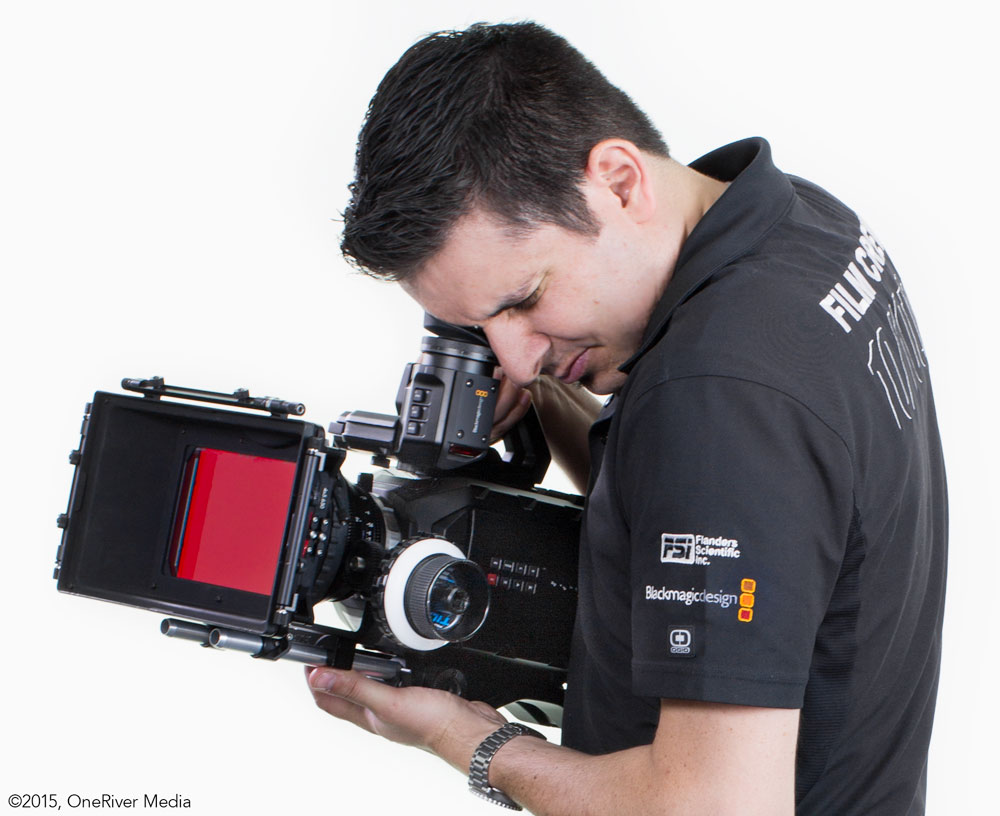
Functionality
Even if Blackmagic had stopped here and released the OLED EVF without any other features, I’d be sold. But not stopping there, they added a multitude of functional and overlay features that really take this EVF to the next step.At the top of the EVF are three buttons. These act as customizable function keys as well as controlling the menu within the EVF as well. For example, the F1 button could be assigned to toggle between focus peaking, F2 could toggle between false color, and F3 could toggle between color and black-and-white mode. I often use focus peaking and 2X zoom mode, so I’ll probably assigned those as F1 and F2 respectively. Whatever you find yourself using the most can easily be assigned to these three function keys.
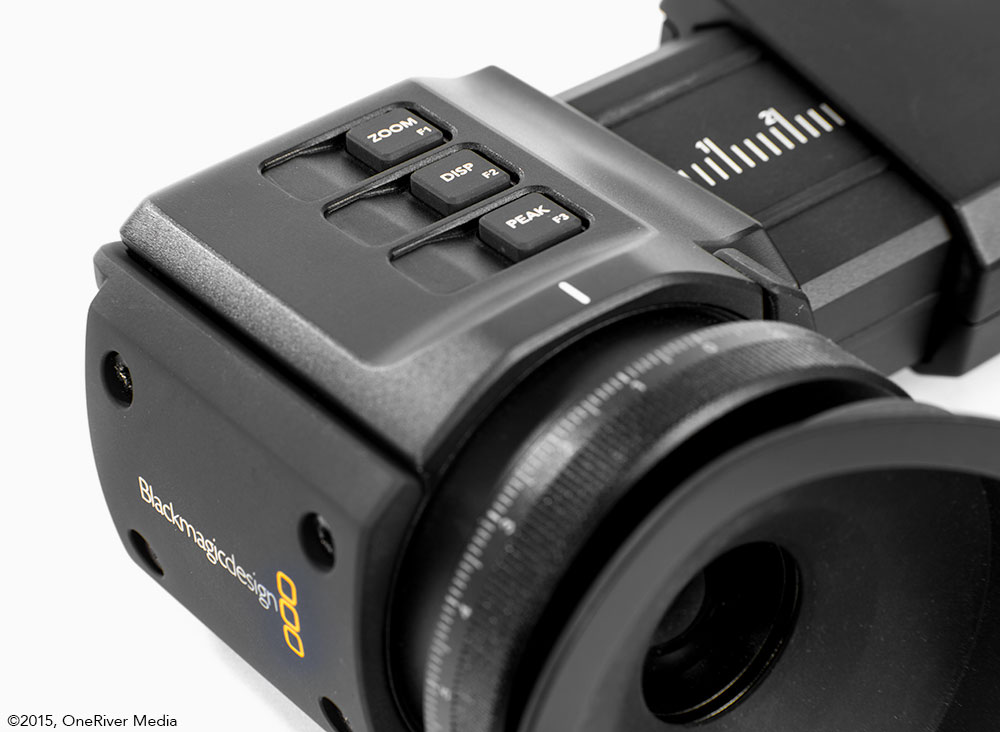
These three function buttons also act as the means to navigating through the EVF’s own internal menu system. It’s a little awkward at first to navigate through these button, but I found myself quickly adapting through the menu system after some practice.
With the addition of a USB port, the firmware inside this EVF is easy to upgrade with whatever forthcoming features Blackmagic decides to incorporate into this unit. Whatever function you don’t see now has the potential to come later.
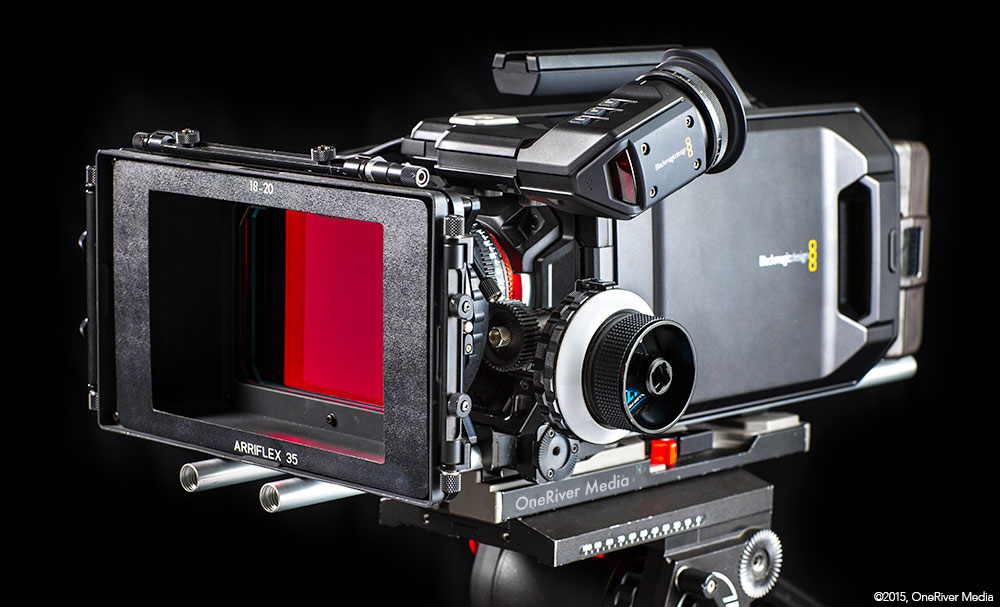
Build Quality
Overall construction is solid and well built. It complements the build quality of the both the URSA and URSA Major with aluminum components and the mentioned high quality glass optics.Adjustability of the unit is very easy. The EVF can adjust forward and backward. Likewise, the eyepiece section can move left and right and tilt up and down. The eye cup can be rotated 360° to suite the shape of your head as well as for right and left eye viewing. I added my Blue Star Oval Extra Large Ultrasuede Microfiber Eyecushion (in red) to the Blackmagic EVF, and although it fit on it, the eye cushion itself is a bit large for it and doesn’t fit as firmly as I’d like. Doable, but not perfect. A smaller eye cushion would be ideal.
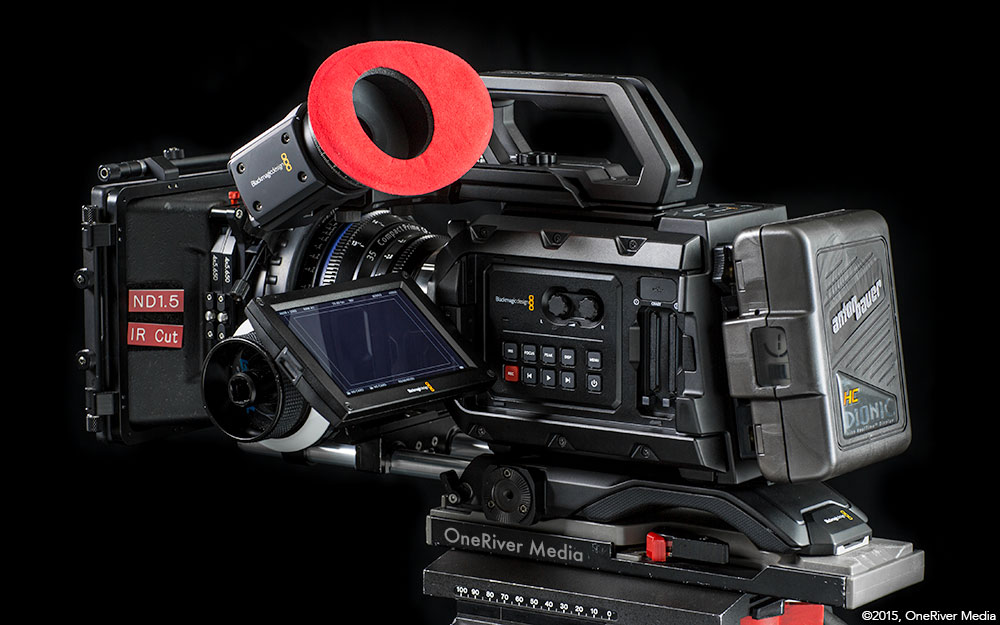
The EVF receives it’s power, video, and data feed from the URSA/Mini’s 4-pin XLR DC port (power) and the SDI port (video/data). The integrated connection cables perfectly fit the length needed for both the URSA and URSA Mini. I’ve mounted the EVF to both cameras and I can confirm the integration with both cameras is truly excellent.
The SDI ports integrates several functions: video, audio (for metering), and data. With regards to data, the URSA/Mini sends a collection of proprietary information to the EVF. For example, the EVF has a red tally light on the front, which is controlled by the camera itself as to when it should be turned on or off.
Features
Like the URSA Mini, the Blackmagic 1080 HD OLED EVF unit I’ve been testing is a prototype beta unit, so anything could change in terms of fabrication, parts, functions, and features. Again, even if this was the shipping version, I’d be more than pleased with the quality as it stands. But with that said, the software inside the EVF could change for the shipping version.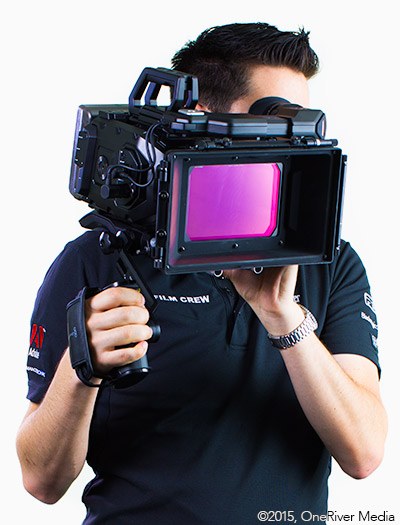
As a prototype beta unit, the EVF currently has the following features:
- Full 1920×1080 raster color OLED
- Adjustable diopter
- Focus peaking
- False color
- Zebras
- Histogram (fast readout)
- Black & white mode
- 1:1 zoom
- Audio meters
- REC709 LUT toggle (when shooting LOG mode)
- Aspect ratio masks, guides, and overlays
- Tally light
- Camera data: ISO, shutter speed, white balance, aperture (on electronic aperture lenses), frame rate, resolution, recording format, clip run time, record/ready mode, power level.
Wish List
What’s currently NOT in the prototype feature set (and I do NOT know if these will be added later) are waveform, vectorscope, and the option to change timecode type (current clip length versus TOD TC, versus remaining record time, etc.). I could live without a vectorscope since we typically use our various Flanders Scientific monitors with integrated vectorscopes in them, namely for chromakey shooting and the like. But having a waveform overlay on the OLED EVF would be a very nice option to have. There is a realtime histogram, which is great, but sometimes a waveform can give a different/better idea of zone exposure and the like, where a histogram cannot. And if a waveform is added down the road, I’d like to be greedy and ask for both a standard waveform and parade waveforms (RGB, Y’CrCb, etc.).It would be great to have an SDI loop-out connector and HDMI in/out, but frankly, I personally don’t really need these since (A) our production shoots are primarily all SDI-based anyway, (B) it would have added considerable size to the EVF, and (C) it would have added more cost to the EVF. Honestly, I think having no additional SDI and HDMI ports is fine, especially since this is designed specifically for the URSA and URSA Mini.
Theoretically speaking, the Blackmagic EVF should work fine with any camera that has an SDI output (and means to connect power to its 4-pin XLR port). But as a prototype unit, I can only speculate on supported features and mounting adapters. I’m assuming it’s in Blackmagic’s interest to sell this EVF to anyone that wants to buy it, whether they’re Blackmagic owners or not, so time will tell if 3rd party rigging manufacturers (like Wooden Camera) will create such adapters. I’m going to lean towards the idea that such adapters will be created; hardware mounting and power adapters… maybe even an HDMI-to-SDI converter box that incorporates the 4-pin XLR connection in a single unit (to also help power the HDMI-to-SDI conversion). It’s anyone’s guess at this point, but for now, URSA and URSA Mini owners have a sleek system that requires no additional adapters nor added bulk.
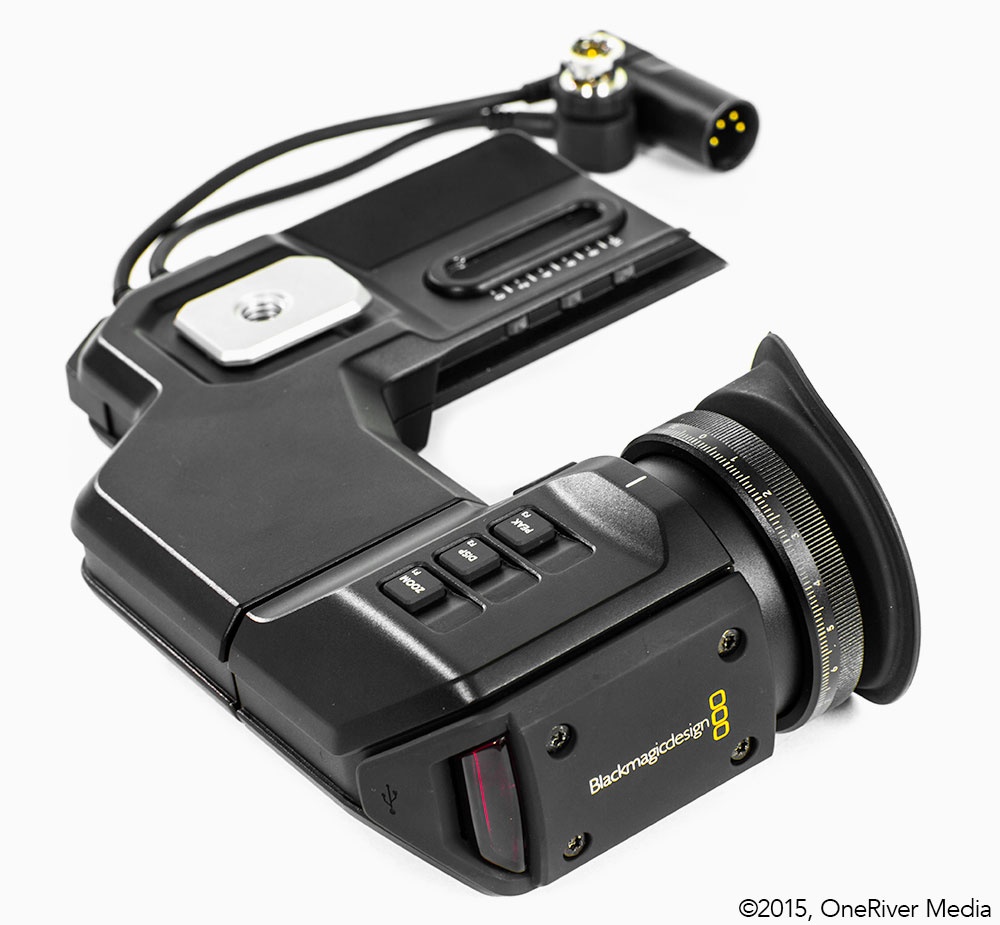
Conclusion
In the end, Blackmagic hit another product home run with this 1080 HD OLED EVF. It’s high quality in every aspect: fabrication, OLED display, optical transmission, features, size, weight, and simplicity. I’ve owned and used many EFVs over the years and they’ve all pretty much been too big and bulky. To add, the screen and optical quality of other EVFs have been typically “just okay” (with some low-cost EVFs just looking downright ugly).There’s absolutely no question that this EVF is the very best solution you could use for the URSA and URSA mini at any dollar amount, let alone the staggering low cost of $1495 that Blackmagic is pricing this unit for; it’s the real deal at any price. At only $1495, it’s truly a no-brainer for any URSA or URSA Mini owner. I’m still a bit shocked this EVF is top-of-the-line quality at such low cost. I really look forward to the shipping version and using it full-time on our production shoots!
If you’re looking to buy the Blackmagic EVF, I’d highly recommend pre-ordering your unit if you haven’t already done so.
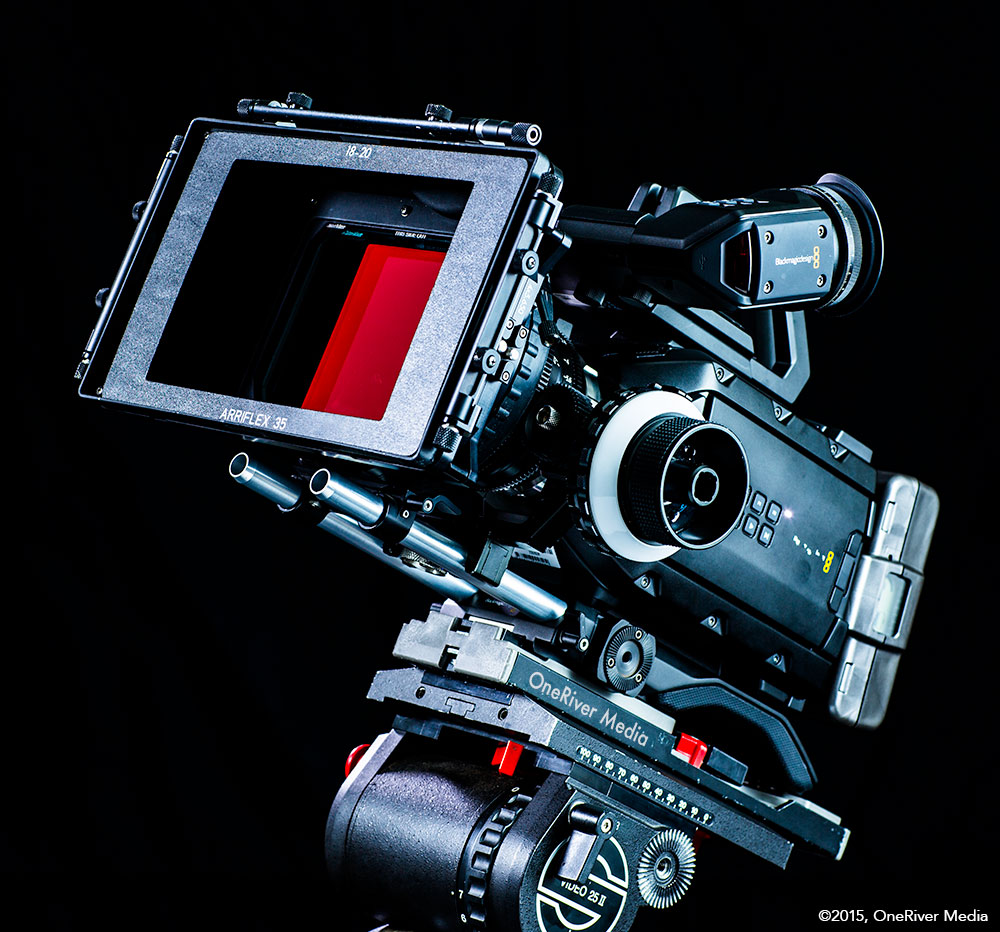
If you’re in Los Angeles on August 26th, register for the FREE Blackmagic Day where I’ll be presenting, “Blackmagic Camera Experiences & Insights” where I’ll discuss my findings with the new Blackmagic 4.6K sensor and the impact it will bring to the filmmaking community as a whole. I’ll also share my experiences using various Blackmagic cameras for my work on feature film production and how that can translate to all forms of production.
Share this post
Article © OneRiver Media, including applicable photographs. All rights reserved. Article and its contents shall not be copied or reprinted without the expressed written approval of OneRiver Media.
FCC Disclaimer - Links from this article might go to affiliate links to B&H and/or Amazon (not much different than the ads you see in YouTube ads, but more focused). Visiting these links (or buying products from the links) cost you nothing additional and may in turn help us pay for the cost of hosting these free articles we write. These articles take an enormous amount of time (in most cases, weeks and months) to research, draft, write, edit, rewrite, and shoot custom photography/video for. In no way do these affiliate links cover the cost of all of that, so any help these links can provide is a huge help to us to continue to offer free content to our readers.
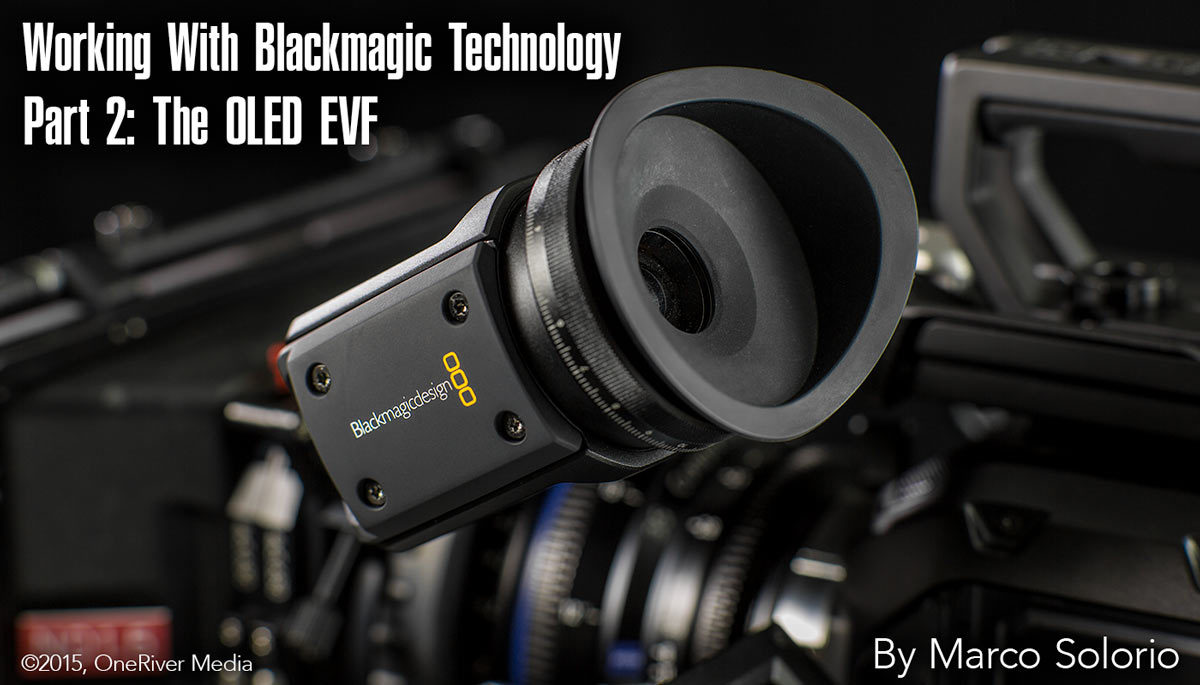
Comments 28
Hi Marco,
Thank you so much for taking the time to review the Ursa Mini and the OLED viewfinder. I have already taken the plunge on pre-ordering the Ursa Mini, but have one question related to either the camera or this viewfinder for which I haven’t been able to find the answer anywhere else online. It is about the 1:1 zoom for focusing.
On my Canon 5d Mark III, when I punch in to check focus, I can move the zoom area around the screen, to check the focus without reframing. However, on my Blackmagic Pocket Cinema Camera, it only seems to zoom in to the centre of the frame. Obviously, when using the rule of thirds, this requires me to reframe to check focus and then reframe again, which is a pretty serious issue when shooting wide open, as the focal plane is very narrow.
So – my question is can you move the zoomed in area on the Ursa Mini screen or the OLED viewfinder, or is it locked in the centre? Many thanks in anticipation of your response! All the best, Jonah
Author
Hi Jonah. Thanks for acknowledging the amount of time involved in the producing of these articles! Yeah, for now it only looks like the 1:1 zoom functionality is only center-pointed. What I typically do to combat this is to pan the camera, focus, and pan back. I know, not ideal. My hope is that with either the final release OR in a forthcoming firmware update after its release that such a re-position of the zoom feature will be added. It’s something that could be done by using the F-keys (or a combo therein) while in the zoom mode. Hope is not lost! Thanks.
Another informative and well written article, thank you! I’ve pre-ordered the Ursa-Mini and this viewfinder and it’s always exciitng to read your findings, in anticipation.
Author
Thank you so much for saying so, Alfie. We’re anxiously awaiting the final release of these products as well! Cheers!
You’re welcome Marco! Keep up the good work and I’m eagerly awaiting your part 3 of the blog, if I’m correct in saying so.
Author
You are indeed correct, Alfie! There will be a part 4 article coming… hopefully sooner than later, but there will be a new product review (not BMD related) before part 4 is out!
Thanks again for another insightful detailed article about BMD products. I was at the BMD Day in Burbank last year and enjoyed your keynote and I’ll be back again this year. By the way are you gonna be covering the Video Assist? I was at CineGear LA 2015 and took the opportunity to test out all the new gear from BMD for 2015 and the screen resolution and quality on the Video Assist and EVF were stunning. DO you know if the Video Assist will accept LUTs?
Author
Thanks for the really great comments, Jeremy! I was actually at the BMD booth at CineGear LA 2015 (I was invited as their guest filmmaker) so maybe we barely missed each other. At any rate, I’ll be covering a little bit about the Video Assist, but not a whole lot. I do however think it’s a great tool. Not completely sure about the ability to accept LUTs at this time. The unit I got to play with was a fairly early prototype unit, so I’m sure more features have been (or will be) added. Like all BMD products, it has a USB port, so anything is possible, whether feature updates or LUT uploads! Cheers!
Hi Marco, i was hoping for some news on LUT integration? and how about an unbiased look at comparing this to the similarly priced but better specs SmallHD 502 Sidefinder? The BM EVF fit’s the cameras so well but it would still mean a LUT breakout box somewhere in the chain or via another monitor, hopefully you’ll get the details in time.
Regards
Anthony
@BampFilm
Not sure how the sidefinder is better spec’d. The Blackmagic EVF is 1920×1080, the sidefinder on the 502 reduces EVF resolution to 1366×768. Blackmagic is OLED for proper black levels, the 502 isn’t.
As far as i can see, the 502 is only better in two ways: user LUTs (some care, some don’t), and maybe that the loupe can detach to use it as a screen, but that could be seen as an advantage for the Blackmagic too.
Not sure…. come on Marco, as far as Zacuto are concered a 1080 panel at this size doesnt make a difference, i’d like to think that wasnt completly biased, it could be but there’s certainly scientific backup to this claim, OLED is definetly better for black levels but the 502 is an onset tool, LUT’s are imporatnt for serious feature film and commercial production, especially for those exposing by a monitor and it’s assist over a traditional light meter, talking of assists the 502 features a waveform not just a histogram which is useless for repeatable consistence exposure within a scene (i’m talking about consistency here) the 502 has anamrophic desqueeze, a wireless control, can send the 3D lut look to other monitors, has SDI and HDMI in/out with cross conversion and can be used as a forward facing monitor for shooters who prefer a monitor over an EVF (there are some crazy people out there Marco) which the onboard URSA monitor can’t really do.
Don’t get me wrong, i think the BM EVF is very nice, if it was included we wouldnt be talking but it’s an OEM optional accessory at the same cost as the 502 and that surely makes the comparison very obvious and worth talking about, especially considering it’s, on paper, better production lead spec?.
It’s worth noting that until the BM EVF Launches the 502’s resolution is the highest in it’s class, wheter or not the BM EVF higher resolution is giong to be needed is up for debate, the OLED is obvioulsy desired but i wouldn’t say it was desired over LUT’s, Waveform, Anamorphic Desqueeze and HDMI in/cross conversion.
Thankyou
@BampFilm
Author
Just for the record, the comment that was originally replied to you was not by me, so your comment might be better referenced to James than myself. With that said however, I’m still in the camp that a true glass optical finder can typically yield better results that one that is comprised of a swing-away loupe method. This is not to say the 502 with the Sindfinder is not a good system (it is, I happily own SmallHD products and have briefly used the 502 with the Sidefinder), but in my own personal preference (tag this with other objective camera findings from person to person), that a true glass optical view finder (like the BMD OLED EVF and the Zacuto Gratical) in compact design result with better marks in my preferences. Keep in mind that you’re obviously only using part of the 502’s high resolution when using the Sidefinder. I do believe the full raster of the BMD OLED EVF is what helps give it that optical viewfinder feel where the individual pixels are imperceivable, but again, this is an objective personal preference. And FWIW, the BMD OLED EVF does anamorphic desqueeze in 3K anamorphic (4×3) mode when shooting with true anamorphics on the camera’s 4×3 sensor mode. With BMD designing this OLED EVF specifically for the URSA/Mini lineup, HDMI in/out/cross and alternative LUTs (for other cameras) is not what their goal was. The URSA/Mini doesn’t need or use HDMI (thank goodness) and LUT to view REC709 from its LOG profile is built in. It might suck for people wanting to use this EVF for other cameras (which I understand), but it’s a non-issue for URSA/Mini shooters. Again, BMD designed this specifically for their own cameras and the cost reflects that, which IMO is great.
If you’re convinced the 502 is a better viewfinder for your needs, then that is absolutely the only reason you should buy/use that viewfinder and not the BMD OLED alternative. Use what works best for you, not what me or anyone else may feel works better for their preferences.
I’m asking questions as I couldn’t possibly know what is best for me as no one has reviewed the BM Oled evf and it looks like you might be first.
I mentioned the different connections and features to make a point that at least on paper it is better spec’d. As for LUT’s, can you at least monitor the Rec709 while recording log in all modes? unless BM install this feature in the camera we might be back to using a breakout box. I couldn’t call it a non issue, we create multiple LUT’s for different projects all the time and sometimes for multiple scenes within a film (I’m primarily a narrative based cinematographer), the Panasonic Varicam understands this.
Look, I’m just going by specs as that’s all I have, ultimately I want the best viewing experience but I also need these fairly basic tools in place for production and BM are not implementing it into their camera or evf then I may have to go the 502 direction or consider another LUT box.
In regards to resolution all of these manufacturers have made the same “can’t see the pixels” remarks and I’m yet to see that for myself, I’ve used 16mm cameras and know what a true optical viewfinder is like (kind of painful as you need to press your eye into the cup to open the viewfinder shutter but no doubt a beautiful viewing experience) and having used the Red Bomb I don’t see an EVF being elevated to that status (I’m sure I’ll change my mind when I get to use these evf’s) so because of my past experience in just looking at the numbers and the functionalty.
Looking forward to a possible unbiased comparison of these EVF’s from Oneriver, I really would rather the BM evf but I’m on a budget and need the tools of the Zacuto/502
Author
Yes, as outlined in both the article and in comments, the OLED EVF can toggle the REC709 LUT on/off when shooting LOG. As I’ve also mentioned, it’s up to BMD to add the ability to import LUTs and could be doable since the EVF has USB. I personally prefer to have my EVF give me a clear baseline for maximum latitude for best exposure rather than a custom look that could potentially reduce that maximum potential, but that it just my own preference. We use Flanders Scientific monitors on set for custom LUT viewing, but again, I my own preference tends to typically want to view maximum DR potential than a stylized look in the EVF. But I do understand the want to have it. Bottom line, wait for the shipping unit and if it still doesn’t have custom imported LUTs, it’s a question and/or feature request for BMD.
In my own experiences, I would definitely not judge an EVF based on the RED Bomb EVF… that particular unit (again, IMO) is a very poor EVF. The image just looks low rez and the fisheye effect is really distracting.
I definitely recommend looking through the BMD OLED EVF and I’ll wager you’ll have a completely different experience, undoubtedly better than the Bomb EVF.
Thanks for the preview, Marco.
I think custom LUTs will be beneficial even for Ursa/Mini users. A rec709 LUT will surely help with focusing, but it usually isn’t representative of the finished look. It would be better to be able to use a custom LUT, I believe.
Author
Thanks, Mike. Please read my latest reply I just posted above about custom LUT importing for EVF use with the BMD EVF.
Totally with you on the Red Bomb….. Crap!!
Does the Rev 709 toggle the camera’s processing of log to rec709 or is the process going on in the evf (if you know? As that’ll give us an idea of what’s possible with the unit.
I get where your preference is coming from but I don’t see LUT’s as some magic bullet plugin, I’m sure with something like 10/10ths is a completly different way of shooting but I leave all the dynamic range decisions to the control of my testing and trust my Sekonic and the scopes, I don’t judge the exposure via a log image on a monitor, probably comes from stills shooting, you compose with an optical viewfinder and check a tethered image with a Lightroom preset, was one of my first struggles with the BMCC camera as it had no downstream LUT support.
By the way, I pretty much bought the BMCC based on your videos Marco, don’t take my comments as anything than enthusiastic debate, I’m going to be buying the URSA mini to bump up my short film and commercial reel while banging on agency doors for representation, I’m very much a controlled lighting shooter these days
Pingback: Blackmagic URSA Viewfinder is Now Shipping Plus New Firmware Update 2.6 | 4K Shooters
Can you tell us how the OLED evf handled a lot of image movement? I have a Zacuto Gratical which gets better with each firmware update but the one important area it’s failing is in handling either movement in frame or camera movement. It’s as sharp as a razor until you pan when the image just goes mushy. As a result, when handholding, focussing is very difficult. Zacuto have recognised this flaw and are looking for a solution but I have a feeling it’s a problem that may be inherent with small OLEDs.. time will tell.
I look forward to seeing a back-to-back comparison of the two. Is BM planning to make this available as a stand-alone EVF?
It looks a bit short to me, like your face would block the FF?
Author
Not sure I understand the question. The EVF is adjustable in several ways: front/back, left/right, rotate up/down.
Hey Marco,
Do you know if BMs EVF can do an image overlay? I believe the Alphatron EVF and maybe the Zacuto Gratical have a feature where you can store an image and or simply bring up an image with 50% opacity while looking through the EVF. Are you aware if this feature exist on the Blackmagic EVF?
Author
Hi Hundo. Currently, BMD has not implemented such an overlay feature, but I believe this is something that they could probably add in firmware if the request was made by enough people. The EVF does have a USB port (mostly for firmware backups) but could also be used to transfer RGBA overlays or still-stores. I’m not sure if there’s a technical limitation or not to facilitating such a feature. I’d maybe post the request on the BMD forum as a feature request and ask others to petition it as well. Never hurts to ask!
Hi Marco, great write up! I have a couple of questions – hopefully you can answer them. I’m trying to figure out if it’s possible to attach the BM viewfinder to the URSA Mini without the BM top handle? The issue is that I already have a Zacuto baseplate and top handle, which I would like to continue using with the URSA Mini. However, I’m trying to figure out how I would attach the Zacuto top handle (which requires a short section of NATO rail or Z-Rail) along with the BM viewfinder. Would a 3″ section of NATO rail fit behind where the viewfinder is mounted, if indeed the viewfinder can be mounted without the BM handle on top of it? Any idea how I could make this work?
Author
Hi Robert. Yes, you can mount the EVF without the top-handle. Unfortunately I can’t test your request with said Zacuto parts, but it appears that there may be enough room (and enough 1/4″ holes) to potentially do what you’re requesting. But I cannot confirm 100%. Here’s a schematic of the holes: Wish I had a better answer for you!
Wish I had a better answer for you!
I looked at the evf on a mini for the first time. I saw very noticeable horizontal lines running through just the evf. It’s not fpn, as it was not present in the flip out screen. Did you ever see it?
Sir in bmd oled evf the image is magnified by the optical lens and viewed and in small hdq 502the big image on the 5in inch monitor is reflected by a mirror and viewed so how the image quality on bmd oled to view is better
Author
The OLED display is magnified just large enough to not be overly large. If your eyeball has to scan around the screen element, then then the element is too big. The OLED EVF maintains a good size ratio for optimal viewing. To add, this is a true 1920×1080 raster at OLED with a very tight pixel density and deep blacks. This results in an EVF that look and feel very much like an actual traditional optical view finder for film.